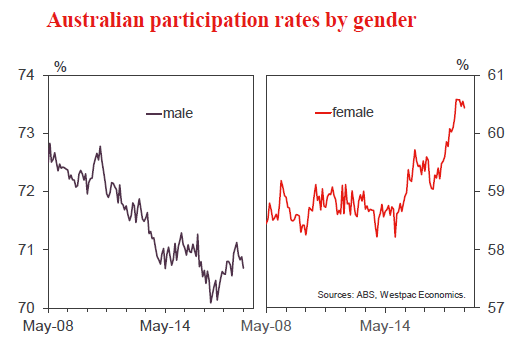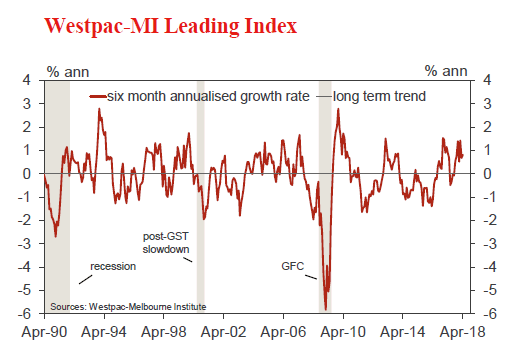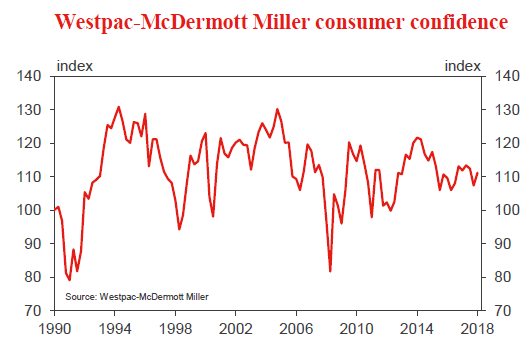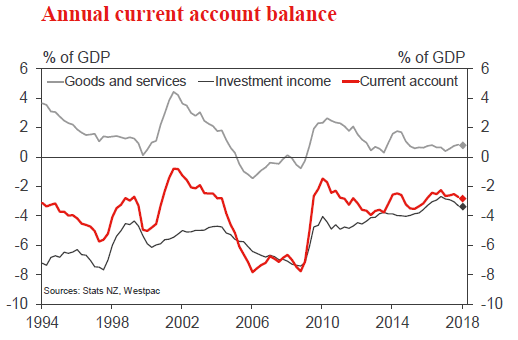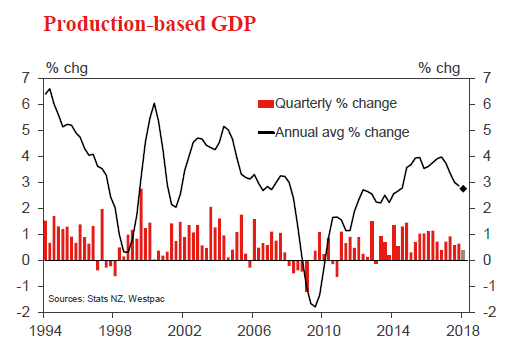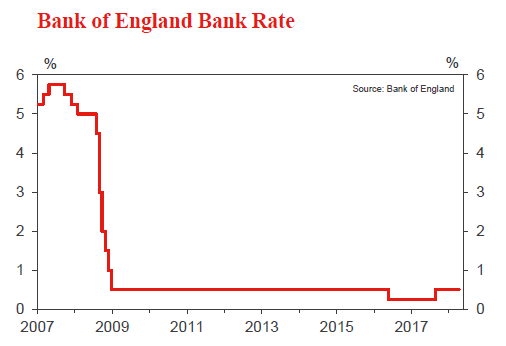Week beginning 18 June 2018
- Some observations from Europe.
- RBA: Governor Lowe on panel in Europe with Fed’s Powell, ECB’s Draghi and BOJ’s Kuroda.
- Australia: Westpac-MI Leading Index.
- NZ: GDP, Westpac-MM Consumer Confidence, current account.
- Europe: ECB Forum on Central Banking.
- US: housing starts & building permits.
- Central banks: BOE, BoT, CBC, BSP.
- Flash PMI’s for US, Europe and Japan.
- Key economic & financial forecasts.
Information contained in this report current as at 15 June 2018.
Some Observations from Europe
Over the last two weeks I have visited policy makers; central banks; real money managers; hedge funds and corporates in Europe and London.
Of course there have been a range of views but in this note I will try to draw out some of the more interesting and prevalent observations that I think are relevant. I will cover the global view; sentiment around Australia and issues for Europe.
The Global View
I was eager to test reactions to our global view which is essentially that the FED will tighten three more times (following the recent June hike) by mid-2019. The US 10 year rate is likely to rise to 3.5% by that time. As the fiscal stimulus fades in the second half of 2019; and the US economy slows under a tightening in financial conditions (higher USD; widening credit spreads; falling equity prices) and a resulting slowdown in spending, the FED will go on hold and US bond rates will gradually ease through the remainder of 2019 and 2020. However we do not expect an inverse US yield curve and a resulting US recession. Nine of the last ten inverse yield curves have correctly signalled a US recession.
While there was some sympathy with this view a common theme amongst investors was that US bond rates were unlikely to rise much above current levels. Sentiment that the FED controlled the front end of the curve but not the back end was commonly expressed. Customers pointed to ongoing issues with emerging markets (exposed to slowing global trade and rising US interest rates and USD); widening corporate spreads; trade disruptions; tightening financial conditions outside the US as USD shortages squeeze countries with current account deficits; and a slowdown in Europe particularly as the ECB and QE.
Concerns around a disruptive trade environment are much more prevalent amongst these customers than in our own view. However no one could confidently enunciate the scenario.
These developments were likely to see an inverse US yield curve emerge in the first half of 2019. My view is that such a curve would not, on this occasion, signal a US recession since the necessary dynamics required for a recession would be for the FED to overshoot as inflation surged. I do not see three more hikes as an overshoot and expect inflation to be contained around the 2% “axis”.
Views on the USD, in that scenario, were for USD strength as the FED was tightening and global risks increased although the turning point in the USD, as a US recession neared, would be much sooner than our own view of around mid 2019 when the FED signalled its pause.
Sentiment on Australia
While the Westpac view of no change in the RBA cash rate in 2018 and 2019 is decidedly non-consensus amongst markets and economists in Australia there was considerable support for that view amongst these overseas customers.
Until recently Australia had not been on the radar screen for investors. Over the course of the last nine months markets have progressively priced out the RBA style “rate hike” scenario. There was considerable curiosity as to why RBA would maintain the line about rates. Investors noted their views around the global environment and tightening Australian financial conditions and, in particular, housing.
Investors could not understand why the RBA would be signalling eventual rate hikes with housing weakening and financial conditions tightening. The rise in BBSW and the common assessment that USD shortages outside the US were likely to intensify at the expense of AUD funding was expressed. Others pointed to tightening liquidity in the Australian markets and rising repo rates, (sovereign repo rates at 2% compared to RBA cash at 1.5%).
For Australia, much depended on the global outlook. Those expressing the view set out above were not confident and were particularly curious about the RBA’s bullish 3.25% growth outlook for 2019.
Our view that Australian bond rates could fall further below US rates was supported by those investors who, like ourselves, expected further increases in US bond rates although those expecting that the US bonds were near the peak did not anticipate further contraction.
Views on the AUD were contingent on the global view including the outlook for China. Generally, an orderly slowdown in China was favoured. No significant risks were perceived around the Chinese financial system, despite our own more cautious advice.
Europe
I am writing this note as Mr Draghi is explaining his latest policy update. The anticipation of these announcements during my visits was intense. The consensus for the timing of the ending of QE was end year but the details were not expected to be announced until July. Some considered that the tapering was necessary given that the ECB was nearing its limit of holding no more than 33% of any existing line of government bonds (a constraint really only for Germany; certainly not Italy). Others were adamant that the ECB needed to send a clear signal to Italy.
Progress on inflation has improved sharply with the rise in energy prices (headline near 2%) although underlying inflation languishes at 1.1%. Unlike UK and Australia wages growth has lifted in the Euro area although this is mainly due to Germany.
There was considerable uncertainty around the output gap in Europe – some argued it had closed totally (potential growth assessed as 1.25%); others talked about a 5% output gap (potential growth of 1.75%). Underlying inflation has been behaving more like the wider assessments.
Economists were surprised and really unable to give a convincing explanation of the sharp downturn in the PMI’s in 2018 with most expecting stability in the second half.
There was extensive criticism of the -0.4% ECB bank deposit rate. While that negative rate served the purpose of pushing banks out along the risk curve with credit spreads and equities benefitting, that process had run its course and negative rates were now simply a tax on banks. That undermined confidence in banks without assisting the real economy or the closure of the output gap.
Today’s guidance of a slower than expected unwind of negative rates will be a disappointment.
Conclusion
As usual, these meetings in Europe/London are exhausting but definitely enlightening. I am going on leave for a few weeks and will have time to contemplate these intriguing times.
The week that was
The past week has been jam packed with data for Australia, the most notable releases being the June edition of Westpac-MI’s consumer sentiment survey and the May labour force release. Offshore, it has been a tale of two central banks: one full of confidence; the other decidedly circumspect over the outlook.
Beginning first with our Westpac-MI consumer sentiment survey, a 0.3% increase was seen in the month of June to 102.1, an outcome above the series’ long-run average but well below the level deemed consistent with a robust consumer. Australian households remain concerned over their family finances and risk averse. This is clearly seen in both the current and 1-year ahead views of family finances remaining below average despite 1-year and 5-year expectations for the economy, and those for the labour market, being robust. On expectations for the labour market, it is worth noting that June saw a sharp increase in unemployment expectations following a material decline over the past year. This comes after a material slowdown in employment growth in early 2018 (more below), and is a point to watch vis a vis household incomes and family finance expectations. On the housing market, recent price weakness is playing through to consumer expectations, with the survey’s house price expectation index now at its lowest level since early 2016. Unsurprisingly, New South Wales and Victoria were the focus of this weakness. Interestingly, it does seem as though recent price declines have (to a degree) alleviated concerns over housing affordability, with the time to buy a dwelling series recording its second highest monthly outcome since September 2016, as a particularly strong gain was seen in NSW.
To the labour force survey for May. While the unemployment rate fell from 5.6% to 5.4% in the month, this was only because of a 0.15ppt decline in participation (see chart of the week). Employment growth was actually below expectations at 12k, with a downward revision to April also reported. Deceleration in job growth in 2018 is seen in the 6-month annualised pace. In January it was 3.6%; it has since fallen to 1.6% at May. As highlighted by Governor Lowe this week, reducing slack in the labour market is not just about creating jobs. The type of job matters a great deal, particularly for income prospects. Adding the additional hours part-time employees would like to work to base unemployment implies a underutilisation rate for labour of near 8.75%, well above the 5.5% unemployment rate averaged through 2018. To see materially higher wages growth, not only does the unemployment rate have to be brought down below 5.0%, but the excess capacity of part-time workers who want to work more also has to be worked through.
The May NAB business survey was also released this week. Key from this report was that, while conditions and confidence both fell in the month, conditions remained well above long-run average levels, and confidence in line. The continued strength in conditions is broad based by state – indicative of synchronised growth across the nation. However, by industry, goods related sectors such as construction and manufacturing remain much stronger than those tied to the consumer.
Turning to overseas developments, the past week has been pivotal for global monetary policy, with both the FOMC and ECB meeting. Broadly, the FOMC franked market expectations by: raising the fed funds rate by 25bps for a second time in 2018; remaining optimistic over economic activity in 2018 and 2019; but cautious on inflation prospects. Together with the activity and inflation forecasts, the median 2018 rates expectation of the Committee shifting from 3 to 4 hikes (as one member altered their forecast) is best construed as evidence that risks are tilting to the upside not that four hikes have been locked in. We continue to forecast a third 2018 hike in September and view a follow-up (fourth hike) in December as a risk if the 10-year yield fails to rise materially above 3.00%. A further two hikes are factored into our forecasts in 2019, taking the fed funds rate to 2.625% (if a fourth hike in 2018 does not occur). As we see neutral as 2.5%, in tandem with a stronger US dollar and the end of increased government spending, this is likely to be enough to cause a material slowdown in growth in late 2018, putting a halt to the FOMC’s hiking cycle come June 2019. The FOMC instead believe neutral to be higher, circa 2.9%, and so expect to be hiking into 2020.
From the ECB, we received two significant announcements: the ceasing of net asset purchases at December 2018 after at 3-month extension at €15bn per month; and a commitment to keep key ECB rates unchanged through northern summer 2019. The latter was most significant for the markets, highlighting downside risks to the outlook and the difficulty that the ECB continues to have in stoking core inflation towards target. The net result on markets of these two meetings is a stronger US dollar (at the expense of the Euro) and lower market rates across the curve in Europe.
For those in search of some weekend reading, the latest edition of Market Outlook has been released. Key themes for the Australian and global outlook as well as the Australian dollar are discussed in depth. Thematic ‘hot topics’ on household incomes & wealth and commodity prices are also of note.
Chart of the week: labour market participation
We noted in the April release that the Australian labour market was more dynamic through 2017 with rising labour demand being met by rising supply – in particular female rich employment gains were being met by rising female participation.
Then as the labour market slowed through the first half of 2018, male unemployment started to rise as male participation was not easing as fast as the moderation in employment. Last month we wondered if this trend would continue boosting unemployment.
Now we know that, at least in May, there was a surge in males leaving the workforce, possibly retiring, which dragged male unemployment down to 5.4% from 5.7%. Female unemployment fell too but it was a smaller decline from 5.5% to 5.4%.
New Zealand: week ahead & data wrap
Slowing momentum
Recent data has reinforced our view that the drivers of New Zealand’s economic growth are becoming more mixed. Next week’s GDP data is likely to show that annual GDP growth slowed to 2.8% in the March quarter – its slowest pace since September 2014 – as momentum in the household and construction sectors has faded. But although New Zealand’s economic cycle is maturing, it’s certainly not all doom and gloom. The strong terms of trade is one noticeable bright spot, with strong incomes in the export sector set to provide a key role in supporting growth.
Much of the slowdown in economic activity has been centred on the household sector, with the cooling in the housing market a key influence. On that front, May REINZ data showed that seasonally adjusted sales were down 0.7% in the month and the average number of days to sell has increased. Nationwide prices eased 0.2% in May, following a similar decline in April.
But beneath the headline result, there are marked differences across regions. The slowdown in the housing market has been most keenly felt in Auckland (and to a lesser extent Canterbury). In Auckland, house prices are now falling gradually on a monthly basis, are down 2% since February. Average prices in the region are now back at August 2016 levels.
Outside of Auckland, house prices rose a touch in May, and are up 6.8% on a year ago. But even that’s still a much more gradual pace of growth than we’ve seen in recent years. A year ago, annual house price inflation outside of Auckland was running at a rate of 11%, and two years ago it was almost 16%.
The slowdown in the housing market in recent months has matched our expectations that the changing policy backdrop would be a significant drag. In March we saw the holding period for taxing capital gains on investment properties extended from 2 years to 5 years (the so called ‘bright line’ test). At the margin, this may have prompted some investors to bring their purchase of properties forward ahead of the changes coming into effect. However, moving forward it has made purchasing property less attractive to investors and speculators.
Looking ahead, we expect the housing market to cool further as more of the Government’s policies designed to slow the housing market move from the drawing board and into practice. Notably, the ban on foreign buyers looks set to come into effect next month. And with recent data showing offshore buyer activity concentrated in Auckland and the Queenstown Lakes District, it seems likely that this policy change will affect these regions the most. In addition, any lift in buying ahead of the new rules coming into effect could have generated a temporary lift in housing market activity, that we would expect to fade going forward. The third policy change proposed by the new Government is the graduated removal of the ability of investors to write off losses on their investment property against other incomes. This will further erode the incentives around property investment and dampen house price growth.
Combined, these policy changes, along with a gradual rise in mortgage rates and slowing population growth, are likely to see annual house price inflation fall to 0% by the end of the year.
With so much of New Zealander’s wealth tied up in housing assets, developments in the housing market have big implications for household spending. Going forward we expect the cooling housing market, combined with slower net migration, will be a significant drag on household spending. Indeed there are already signs that the pace of growth in retail spending has stalled. This week’s data showed electronic card spending rose just 0.5% in May, with spending levels essentially flat since January (albeit at a high level). And the pressure doesn’t look set to ease any time soon. Rising oil prices and forthcoming fuel tax increases mean filling the petrol tank will eat up a greater share of household income, and will likely force households to trim other spending.
Softness in the consumer sector is also likely to feature in next week’s March quarter GDP release. We expect 0.4% GDP growth in the quarter, which would mark the third consecutive quarter of subdued growth (GDP expanded by 0.6% in the September and December quarters of 2017).
Sectors that touch on a wide range of economic activity – such as transport, retail, wholesaling and business and personnel services – are all expected to show weak growth or even outright declines. In contrast, the strongest growth is likely to be in the public sector. We should note, however, that the main indicator for this in the national accounts is the Government’s personnel expenses – a measure of inputs, which doesn’t necessarily translate into more outputs. The support to growth generated by a lift in the delivery of public services is more a story for 2019 and beyond.
But it’s certainly not all doom and gloom for the New Zealand economy. Although some of the recent drivers of growth are fading, New Zealand’s strong terms of trade remains a bright spot. The terms of trade eased a touch in the March quarter. But that’s coming off an all time high reached at the end of 2017. The strong terms of trade has been helped by broad based strength in New Zealand’s key export commodities. Almost everywhere you look, farmers and growers are benefitting from high international prices for their products thanks to a combination of robust global demand and, in some cases, tight supplies. While we expect international commodity prices to ease over the coming months as growth in China slows, a weaker NZ dollar should buffer the effect at the farm and orchard gate. This should help the export sector take a bigger role in the economy as momentum in household spending fades.
Data Previews
Aus May Westpac-MI Leading Index
- Jun 20, Last: 0.82%
The six month annualised growth rate in the Leading Index increased slightly from +0.77% in March to +0.82% in April. The above trend signal continues to come mainly from ‘offshore’ components – commodity prices and US industrial production – with domestic components largely flat.
The May will include updates on: the ASX200, up 0.5% vs 3.9% last month; the Westpac-MI Consumer Expectations Index, down -1% vs 0.8% last month; commodity prices, up 0.6% (in AUD terms) vs -3.2% last month; dwelling approvals, down -5% vs 3.5% last month; the yield spread, widened 15bps vs a 11bps narrowing last month; the Westpac-MI Unemployment Expectations Index, up 5.7% vs -4.5% last month; and total hours worked, -1.4% vs 1.2% last month.
NZ Q2 Westpac McDermott Miller consumer confidence
- Jun 20, Last 111.2
Households perked up at the start of 2018. The Westpac McDermott Miller Consumer Confidence Index rose 3.8 points in March, taking it to a level of 111.2. That reversed most of the drop seen in the wake of last year’s election and took consumer confidence back to around average levels.
The June survey will provide an update on how consumer confidence has fared in the face of changing conditions in the economy, including the slowdown in the housing market.
NZ Q1 current account, % of GDP
- Jun 20, Last: -2.7%, Westpac f/c: -2.8%, Mkt f/c: -2.8%
We expect the annual current account deficit to widen slightly to 2.8% of GDP. While goods imports remained firm, New Zealand’s export performance worsened in the first quarter due to a drop in both prices and volumes. This decline is likely to be short-lived: commodity prices have since improved, and we suspect that the drop in volumes was due to the timing of shipments.
We expect a slight narrowing of the investment income deficit for the March quarter, with a pullback in profits of overseas-owned firms after a few unusually strong quarters. However, the deficit is still likely to be larger than it was a year ago, contributing to a widening of the annual current account deficit.
NZ Q1 GDP
- Jun 21, Last: 0.6%, Westpac f/c: 0.4%, Mkt f/c: 0.5%
Following only modest growth in the December quarter, we expect that GDP growth softened again in March. We’re forecasting only a 0.4% rise over the quarter. That would pull annual GDP growth down to 2.8%, which would be the slowest pace since 2014.
We expect the strongest growth to be in the public sector. We also expect a lift in agriculture, and a related lift in food manufacturing.
However, a wide range of economic activity – such as transport, retail, wholesaling, and business and personal services – are expected to show weak growth at best, or even outright declines.
UK Bank of England Bank Rate Decision
- Jun 21, Last: 0.5%, Westpac f/c: 0.5%, Mkt f/c: 0.5%
We expect the Bank of England to keep the Bank Rate on hold at its June policy meeting.
Despite a sharp rise in fuel prices, annual headline inflation remained at 2.4% in May. In addition, core inflation is sitting at 2.1%yr – only just above the Bank of England’s 2.0%yr target.
The BOE is still expected to signal that gradual, limited rate increases will eventually be required. However, with the combination of fairly well contained core inflation, subdued economic growth, and lingering downside risks associated with Brexit, rate hikes are still some way off.




